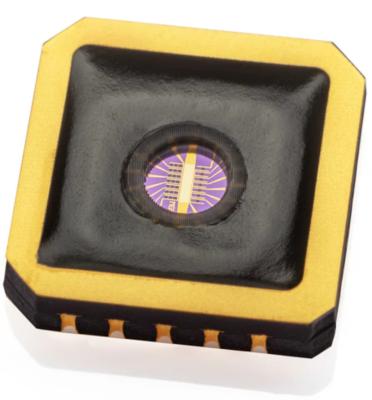Graphene sensors: introduction and market status - Page 8
Graphenea takes part in effort to achieve ultrasensitive detection of SARS-CoV-2 spike protein using graphene field-effect transistors
Researchers from Graphenea, Ikerbasque, BCMaterials, Center for Cooperative Research in Biomaterials (CIC biomaGUNE) of the Basque Research and Technology Alliance (BRTA), University of the Basque Country UPV-EHU, University of Trieste and Universidade da Coruña recently reported a graphene field effect transistors (GFET) array biosensor for the detection of SARS-CoV-2 spike protein, using the human membrane protein involved in the virus internalisation: angiotensin-converting enzyme 2 (ACE2).
By finely controlling the graphene functionalization, by tuning the Debye length, and by deeply characterizing the ACE2-spike protein interactions, the team managed to detect the target protein with an extremely low limit of detection (2.94 aM).
Researchers develop improved method for producing graphene-based gas sensors
Researchers from Penn State and University of Electronic Science and Technology of China recently enhanced their gas sensor manufacturing process through an in situ laser-assisted manufacturing approach, improving on their previous method of drop casting (dropping materials one by one onto a substrate using a pipette.
Flexible gas sensors can be used as medical devices to identify health conditions by detecting oxygen or carbon dioxide levels in the breath or sweat. They are also useful for monitoring air quality in indoor or outdoor environments by detecting gas, biomolecules and chemicals.
Researchers develop graphene-based olfactory sensors to detect odor molecules
Researchers at Tokyo Institute of Technology (Tokyo Tech) and Toshiba Corporation recently demonstrated how graphene-based olfactory sensors could detect odor molecules depending on the design of peptide sequences. They showed that graphene field-effect transistors (GFETs) functionalized with designable peptides could be utilized to develop electronic devices that imitate olfactory receptors and then emulate the sense of smell by selectively detecting odor molecules.
Olfactory sensing is an integral part of many industries like food, cosmetics, healthcare, and environmental monitoring. Currently, most commonly utilized methods for detecting and evaluating odor molecules is called gas chromatography–mass spectrometry (GC–MS). While GC–MS is effective, it has certain limitations like confined sensitivity and heavy setup. As a result, researchers are in the search of user-friendly and highly sensitive alternatives.
Graphene helps NIST team to improve its flagship device for measuring mass
The National Institute of Standards and Technology (NIST) houses a room-sized electromechanical machine called the NIST-4 Kibble balance. The instrument can already measure the mass of objects of roughly 1 kilogram as accurately as any device in the world. But now, NIST researchers have used graphene to further improved their Kibble balance’s performance by adding to it a custom-built device that provides an exact definition of electrical resistance.
The device is called the quantum Hall array resistance standard (QHARS), and it consists of a set of several smaller devices that use a quirk of quantum physics to generate extremely precise amounts of electrical resistance. The improvement should help scientists use their balances to measure masses smaller than 1 kilogram with high accuracy, something no other Kibble balance has done before.
Graphene-enhanced firefighting gear can reduce firefighters' rate of injury and mortality
Researchers from China's Xi’an Polytechnic University, Tsinghua University, Chinese Academy of Sciences CAS) and Shaanxi Textile Research Institute have found that breathable electrodes woven into fabric used in fire suits have proven to be stable at temperatures over 520ºC. At these temperatures, the fabric is found to be essentially non-combustible with high rates of thermal protection time at the maximum values recorded so far for such technology at 18.91 seconds.
The results show the efficacy and practicality of Janus graphene/poly(p-phenylene benzobisoxazole), or PBO, woven fabric in making firefighting “smarter”, with aims to manufacture products on an industrial scale that are flame-retardant but also intelligent enough to warn the firefighter of increased risks while facing flames.
Graphenea expands its mGFET product line with an integrated reservoir for biosensing in liquid
Graphenea recently upgraded its mGFET line of products with a built-in reservoir for liquids. This enhancement increases ease of use for biosensing and implementation in clinical testing and rapid screening.
The mGFET product line is designed to minimize barriers to adoption of graphene as a biosensor. The product was launched at the same time as the Graphenea Card, a socket for housing the mGFET and interfacing with measurement electronics. The addition of the built-in reservoir lets the user focus on the biochemistry, without worrying about producing the graphene or the sensor, or about interfacing.
Graphene transistor enables high-speed, high-sensitivity terahertz detection
Researchers from Japan's Tohoku University and RIKEN have successfully detected terahertz waves with fast response and high sensitivity at room temperature.
On the electromagnetic spectrum, which comprises everything from radio waves to X-rays and gamma rays, there is a deadzone where conventional electronic devices can hardly operate. This deadzone is occupied by terahertz waves. With wavelengths of approximately 10 micrometers to 1 millimeter, terahertz waves are unique amongst electromagnetic waves. Their vibration frequency overlaps with the molecules that make up matter, and they allow for the detection of substances, since almost every molecule operating in the terahertz band has a fingerprint spectrum. Technologies capable of harnessing the power of terahertz waves could have massive significance for the development of spectroscopy, imaging, and 6G and 7G technologies.
Graphene e-tattoo can measure stress levels
Researchers at The University of Texas at Austin and Texas A&M University have used electronic tattoo (e-tattoo) technology to measure stress levels, by attaching a device to people's palms (AKA electrodermal activity or EDA sensing). The researchers created a graphene-based e-tattoo that attaches to the palm, is nearly invisible and connects to a smart watch.
In June 2022, researchers from the same universities also developed a graphene-based electronic tattoo that can be worn on the wrist for hours and deliver continuous blood pressure measurements at an accuracy level exceeding nearly all available options on the market today.
Graphenea reports excellent market reaction to its mGFET devices
In June 2022, Graphenea launched its latest product out of its Graphene Foundry, the mGFET, fully-packaged mini graphene-based field effect transistors.
Graphenea now updates that the market demand for these products has been excellent, and it has run out of stock. The company is now working to produce more mGFET devices and restock.
The mGFETs are Graphenea's highest value-chain products, which are manufactured and packaged in chip carriers, and can be used together with the Graphenea Card for seamless sensor development (which was released earlier in 2022, and has also seen very good reception in the industry).
Researchers develop graphene-enabled single fiber actuator inspired by human muscles
Researchers at the Korea Advanced Institute of Science and Technology (KAIST) and Pusan National University in South Korea recently developed a graphene-enhanced actuator for robotics applications, that is inspired by mammalian skeletal and muscle structures. The new actuator is based on soft fibers with strong contractive actuation properties.
The team explained that they based their work on liquid crystal elastomer (LCE) actuators, promising soft actuator materials with unusually large reversible dimensional change (shrink/relaxation) upon actuation, which is rarely observed in other kinds of actuator materials but highly significant to ideally mimic natural skeletal muscle behavior. Many actuators developed in the past are based on LCE materials, a class of polymers that can rapidly change shape in response to environmental stimuli. Despite their shape-morphing advantages, LCE polymers are known to be associated with the relatively poor mechanical properties and weak actuation behavior. To overcome this limitation, the researchers incorporated graphene fillers within the LCE actuators. In addition to enhancing their mechanical properties, the team expected the graphene fillers to enable light-driven, rapid and remotely controllable actuation, owing to the photothermal conversion capability of graphene.
Pagination
- Previous page
- Page 8
- Next page









